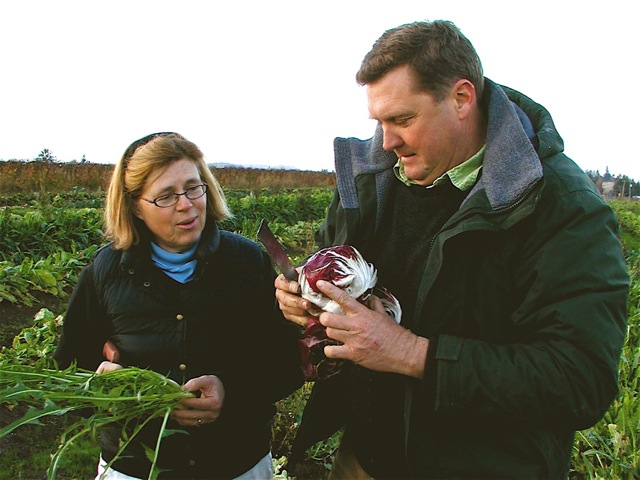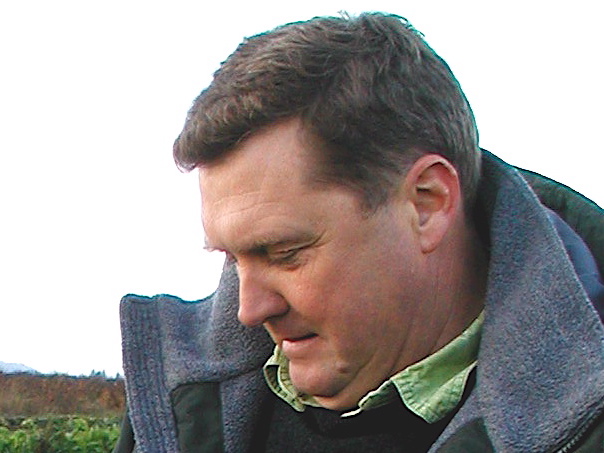
promo-image, l
(article, Anne Laufe)
[%pageBreakSettings nobreak=true] p(blue). Before buying Ayers Creek Farm in 1998, Anthony Boutard was a forester with 1000 Friends of Oregon, an organization that works to preserve farmland and plan for sensible urban growth. Boutard and his wife, Carol, have been mucking about with plants for more than 30 years; they got their start on a community-garden plot in southwest Portland, Oregon. p(blue). These days the Boutards run a 100-acre farm in Gaston, about 30 minutes west of Portland, where they grow a quarter-million pounds of blackberries annually, as well as more than 75 varieties of vegetables that they sell to restaurants and at a weekly farmers’ market. Boutard is a staunch proponent of biodiversity and an outspoken advocate for small farms. You say that you’re just as busy in the winter as you are in the summer. What are your main winter crops? The Pacific Northwest is a great place to grow greens in the winter — it's mild and wet. Our winter greens and vegetables are all grown in the open field. Our season extension is accomplished through variety selection rather than costly tunnels and greenhouses. Last year we experimented with a cooking-greens bag containing borage leaves, mustards, rapas, radish greens, Catalogna chicory, arugula, thistles, kale, fenugreek, and other aromatic herbs. We were tempted to call it the "Saag Bag," after the Indian dish of fragrant greens. We recommend chopping the greens and then cooking them in an ample pot of salted boiling water until just tender. [%image promo-image float=right width=400 credit="Photo courtesy Anthony and Carol Boutard" caption="Carol and Anthony Boutard on their farm in Oregon."] We also grow endives and escaroles, which are wonderful in salads. The larger escaroles are wilted in a pan with olive oil or duck fat, and used in soups or as a side dish with a squeeze of lemon. What motivates you as a farmer? Planning a very good meal. Sometimes it takes five years. Greengage-plum tart? Five years in the making. Actually, it’s been about seven years. So when we finally have that tart, it’s really good. We’re pretty much unique in that we grow a lot of pole-type dry beans. They’re disappearing. Some of the most delicious types of beans on earth are the pole types, because they tend to mature slowly and have a very, very delicate texture and a very fine flavor, but they’re expensive to grow. We stick out thousands and thousands of poles in the field, and then they grow up those poles and they have to be picked by hand, so it’s much more time-consuming. But ultimately you get this incredible bean. It’s just multi-dimensional, multi-disciplined, it’s something that both Carol and I do together, it’s constantly strategic, figuring out what you can sell and can’t sell, and what you can and can’t grow. Tell me about your interest in heirloom crops. One of the things we enjoy doing is understanding the culinary history of the crops. I’m not a pure heirloom farmer, but I like to know how something’s used and understand its culinary quality. I love crops where there’s this big, huge range. With beans you run into this whole separate language. What’s the flavor? Is it nutty? Is it sweet? Is it fruity? You have the skin. How thick is the skin? And does it have its own flavor? Some have a distinct flavor, some don’t. Then you have the pulp itself, inside the bean, the bean itself. Is it smooth, is it flowery? There’s one I grow that’s called cocoa blanc that’s very flowery, and there are the creamy, smooth types. Then there are some that are frankly kind of grainy, and the worst ones are awful because they just taste like sand. Do you sell most of these lesser-known beans to local chefs? I would say our most adventuresome people are our individual customers at the farmers’ market. Chefs have a menu, so it’s always a challenge, and the restaurant also has a character. If they have to sell the black Basque beans, it’s a tough sell, because people assume black beans are black turtle beans, so chefs sort of shy away from that. With our individual customers, I tell them, “This is different.” They’ll understand it and they’ll get hooked. You sell at the farmers’ market, but you don’t do a CSA. What’s your take on CSAs? I think, as with everything, it depends on the personality of the farmer. I’ve talked to some farmers who are currently doing CSAs and they’re saying they’re going to get out of it, because it is so demanding. People have this share and they expect this stuff and it’s very difficult on you. If I don’t have squash on time for the farmers’ market, well, I shrug my shoulders. When you’re providing a CSA box and you’re the one farm that’s not providing squash, you feel kind of foolish. Planning out your season is much more demanding. There's also a kind of hybrid between the farmers' market and a CSA. Instead of having a fixed market basket and everybody gets the same thing each week, the farmer posts an email saying, "I've got a hundred pounds of squash I'm going to sell this week, or 5,000 squash blossoms." People write back and say, "Pass me 100 squash blossoms and three pounds of zucchini and five pounds of green beans." Then that box is delivered to a certain fixed place. If you run short, it's fine; you just say, "We're sold out." I think this is a bit easier \[than doing a traditional CSA\]. It's essentially what we do for the restaurants. I call up the restaurants and go through my list; when I'm sold out of one thing, I cross that off and say, "This is what I have, minus that." I think this is what a lot of farmers who do CSAs and also market farmers will be looking at. Do you consider federal regulations a big impediment to farming at this time? It’s a concern. You need a certain amount of freedom in order to be creative, or you work under the radar and try to find places where we don’t have all these standards. If you look at standards for cherries, or even berries, they’re nonsensical. They have nothing to do with flavor, nothing to do with actual fruit quality; they have to do with the size and appearance. A big apple is a Grade A. At the farmers’ market I can walk in and tell people, “These are good, and they’re little. You may have to pop a worm out, but don’t worry, these are going to be a deep pleasure that you’ll lust after in the future.” Do you have any thoughts about how getting fresh, healthful food is still pretty exclusive and how we can get more healthful food to low-income people? I think that’s a specious argument. People make choices. I have a lot of low-income people buying from me at Hillsdale Farmers’ Market. It’s not a wealthy community, and a lot of people make a decision that they’re going to buy good food. The paradox is that really good whole food is not that much more expensive. It’s often cheaper. As long as people are allured to buying bottled water, and cornflakes that have just a few pennies worth of corn in them, or Coca-Cola with a few pennies of sugar and food coloring, I’m not going to apologize for taking the time to grow a really great vegetable. And people have to make that decision, whether they want a high-density, nutrient-rich vegetable or a cheap one. p(bio). Anne Laufe is a freelance writer who lives and eats in Portland, Oregon.

promo-image, l

featurette-image, l

reference-image, l